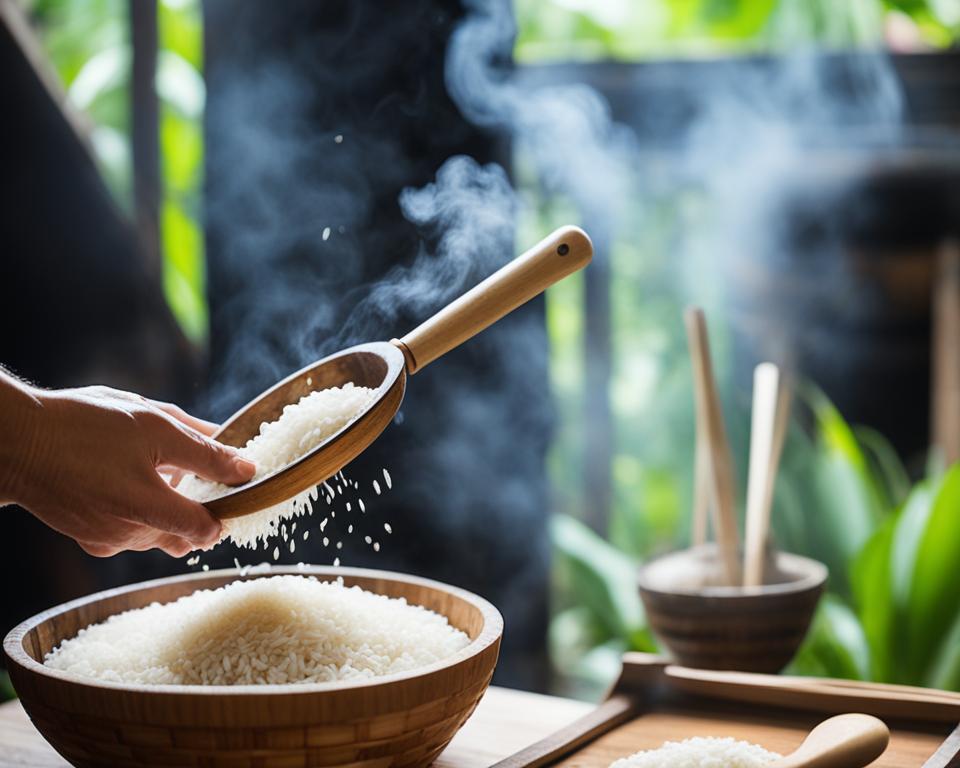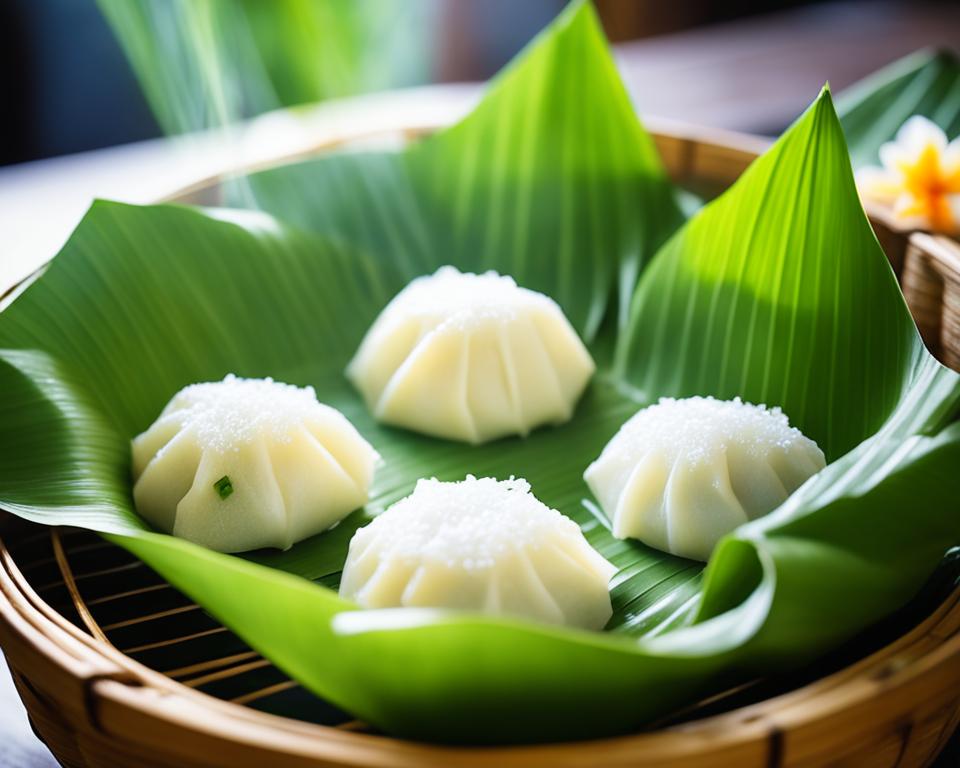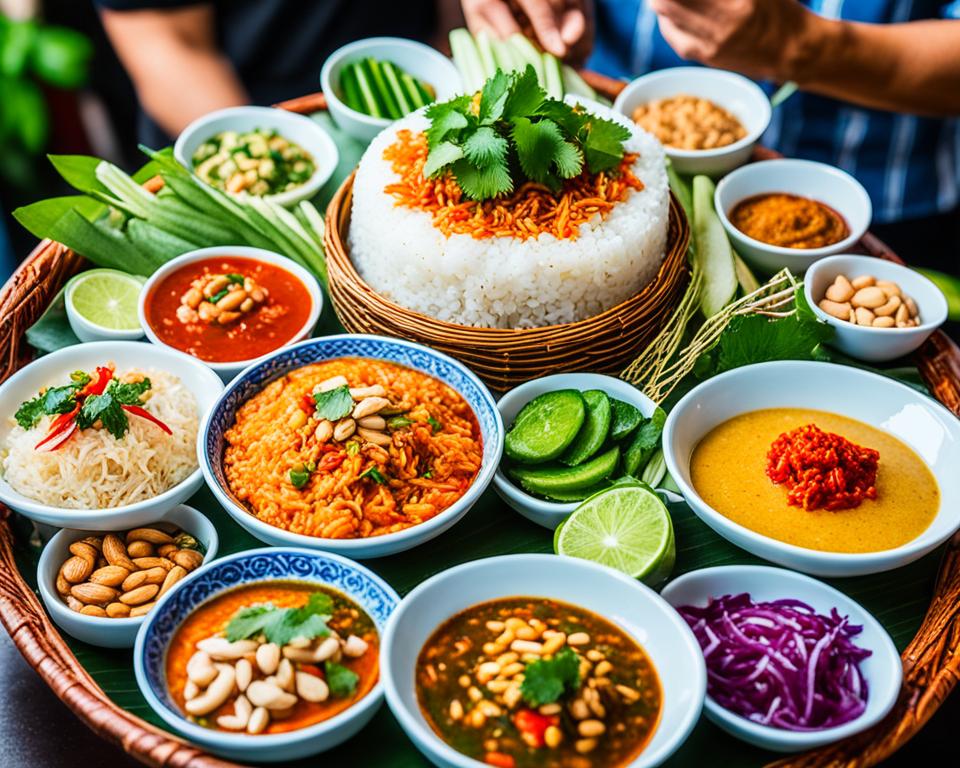Welcome to the ultimate guide to Thai sticky rice cooking! If you’re a fan of traditional Thai cuisine, then you’re in for a treat. In this comprehensive guide, we will unveil the secrets to making the perfect Thai sticky rice. From exploring the various sticky rice cooking methods to sharing expert tips, we’ll help you create an authentic taste of Thailand’s beloved dish.
Thai sticky rice, also known as glutinous rice or sweet rice, holds a significant place in traditional Thai cuisine. Its higher starch content gives it a unique sticky and chewy texture, perfect for accompanying flavorful curries, grilled meat or fish, and other dishes. Whether you’re a novice cook or a seasoned food enthusiast, our guide will equip you with the knowledge and techniques to master the art of Thai sticky rice cooking.
Read more interesting information at ::thekitchenbookstore
What is Thai Sticky Rice?
Thai sticky rice, also known as glutinous rice or sweet rice, is a staple in Thai cuisine. Unlike regular rice, sticky rice has a higher starch content that gives it a sticky and chewy texture when cooked. It is a versatile ingredient used in both savory dishes and desserts.
Thai sticky rice is an essential component of traditional Thai cuisine, offering a unique taste and texture that elevates any dish. Its natural stickiness makes it perfect for shaping into dumplings and creating delightful bite-sized treats.
Whether it’s served with curries, grilled meats, or paired with fresh fruits for a delectable dessert, Thai sticky rice adds an irresistible touch to any meal.
“Thai sticky rice is not just a food, it’s a cultural icon. It brings people together and represents the heart and soul of Thai cuisine.”
If you’re looking to venture into the world of Thai cooking, understanding the characteristics and versatility of Thai sticky rice is essential. In the following sections, we will explore different cooking methods, recipes, and tips to empower you in creating authentic and delicious Thai sticky rice dishes.
The Importance of Thai Sticky Rice in Traditional Thai Cuisine
Thai sticky rice plays a fundamental role in the rich tapestry of traditional Thai cuisine. As a staple food, it holds a significant place in Thai culinary traditions and is an integral part of the dining experience. The unique texture and ability of sticky rice to absorb flavors make it the perfect accompaniment to a wide range of Thai delicacies.
In traditional Thai meals, sticky rice is often served alongside flavorful curries, grilled meat or fish, and other dishes. Its chewy and sticky texture adds a satisfying element to the meal, creating a delightful contrast to the other components on the plate. Sticky rice acts as a versatile canvas, complementing the vibrant flavors of Thai cuisine and providing a comforting base.
The cultural significance of Thai sticky rice cannot be overstated. It is not merely a side dish but a symbol of togetherness, as it is often shared among family and friends during meals and celebrations. The communal act of passing around a basket of steamed sticky rice fosters a sense of unity and warmth, embodying the Thai spirit of hospitality.
Through its versatility, sticky rice can adapt to different flavor profiles and cooking techniques. Whether it’s pairing with tangy and spicy curries, savoring it alongside succulent grilled meats, or enjoying it as part of a refreshing salad, sticky rice elevates the flavors of traditional Thai dishes.
“Thai sticky rice enhances the dining experience by providing a texture and taste that is uniquely Thai. It adds a delightful chewiness that elevates every bite of the meal, creating a harmonious balance of flavors.” – Chef Sommai, renowned Thai culinary expert
When cooked to perfection, Thai sticky rice contributes to the overall harmony of flavors in a meal, acting as a binding force that brings all the elements together. Its ability to absorb the essence of the accompanying dishes heightens the dining experience, capturing the essence of traditional Thai cuisine.
Next, we will explore the different types of Thai sticky rice and the role they play in creating diverse culinary delights.
Types of Thai Sticky Rice
When it comes to Thai sticky rice, there are different varieties to choose from. The two most popular types of Thai sticky rice are white sticky rice and black sticky rice. Let’s explore each variety and discover their unique characteristics:
White Sticky Rice
White sticky rice, also known as glutinous rice or sweet rice, is the most commonly used variety in Thai cuisine. It gets its name from its sticky and chewy texture when cooked. Native to Southeast Asia, white sticky rice has a slight natural sweetness that complements both savory and sweet dishes.
Black Sticky Rice
Black sticky rice, also known as black glutinous rice or black sweet rice, is a darker variety with a nuttier flavor. It is often used in traditional Thai desserts like Black Sticky Rice Pudding. The deep purple hue of black sticky rice adds an eye-catching visual appeal to dishes, making it a favorite among chefs and food enthusiasts.
Both white and black sticky rice require special cooking techniques to achieve the desired texture. While white sticky rice is more commonly used, black sticky rice offers a unique flavor profile and is a delightful addition to desserts.
“White sticky rice is the go-to choice for most Thai dishes due to its versatile nature. However, black sticky rice with its rich flavor and contrasting color adds an interesting twist to both savory and sweet recipes.” – Chef Nongkran Daks
Comparison: White Sticky Rice vs. Black Sticky Rice
| Aspect | White Sticky Rice | Black Sticky Rice |
|---|---|---|
| Color | White | Black / Dark Purple |
| Flavor | Mild, slightly sweet | Nutty, earthy |
| Texture | Sticky, chewy | Sticky, slightly chewy |
| Common Uses | Main dishes, side dishes, desserts | Desserts |
As you can see, both varieties of Thai sticky rice have their own distinct characteristics and are the perfect canvas for creating authentic Thai dishes. Whether you choose white sticky rice for its versatility or black sticky rice for its unique flavor, experimenting with different types of sticky rice will open up a world of flavors and culinary possibilities.
Soaking and Preparing Thai Sticky Rice
Preparing Thai sticky rice is a crucial step in achieving the perfect texture and flavor. Soaking the rice before cooking is essential to ensure even cooking and to achieve that delightful sticky consistency. Follow this step-by-step guide to soaking and preparing sticky rice for optimal results:
Step 1: Washing the Rice
To start, thoroughly wash the sticky rice in cold water. Gently rub the grains together with your fingers to remove any excess starch or impurities. Rinse and repeat until the water runs clear.
Step 2: Soaking the Rice
After washing the rice, it’s time to soak it. Place the washed sticky rice in a large bowl and cover it with enough water to submerge the grains completely. Let the rice soak for at least 4 hours or overnight for best results. This soaking process helps soften the grains and ensures even cooking.
Step 3: Draining the Rice
Once the soaking time is complete, drain the soaked rice using a fine-mesh sieve or colander. Make sure to remove all the excess water to prevent the rice from becoming mushy during cooking.
Step 4: Steaming or Boiling
Now that your sticky rice is ready, you can proceed with your preferred cooking method. Steaming is the traditional method and provides the best results for achieving that sticky, chewy texture. Use a bamboo basket or a steamer to steam the rice until it becomes tender and fully cooked.
“The soaking process is key to ensuring the perfect texture and consistency in Thai sticky rice.” – Thai Cuisine Expert
Alternatively, you can also boil the soaked rice if you prefer a quicker cooking method. Place the drained rice in a pot, add enough water to cover the grains, and bring it to a boil. Reduce the heat and simmer until the rice is tender and has absorbed all the water.
Remember to follow the specific cooking instructions for the sticky rice variety you are using, as different types may require slightly different cooking times.
Step 5: Fluffing the Rice
Once the sticky rice is fully cooked, it’s time to fluff it. Gently use a fork or a rice paddle to separate the grains and create light and fluffy rice. This step helps to release any excess moisture and ensures that each grain is perfectly cooked.
Now your Thai sticky rice is ready to serve alongside your favorite dishes, from flavorful curries to grilled meats and desserts.
| Benefits of Soaking Thai Sticky Rice |
|---|
| 1. Ensures even cooking and prevents unevenly cooked rice. |
| 2. Softens the grains and enhances the sticky consistency. |
| 3. Removes excess starch and impurities for cleaner, tastier rice. |
| 4. Allows the rice to absorb water, leading to a more tender texture. |
| 5. Enhances the overall flavor and aroma of the sticky rice. |
Steaming Thai Sticky Rice
When it comes to cooking Thai sticky rice, steaming is the traditional and preferred method. Steaming allows the rice to cook evenly and helps achieve the desired sticky and chewy texture. Additionally, steaming is the preferred cooking method for those following a gluten-free diet, as sticky rice is naturally gluten-free.
There are various steaming methods you can use to cook Thai sticky rice. One popular method is steaming the rice in a bamboo basket. The bamboo basket allows for proper ventilation, ensuring that the rice cooks evenly without becoming mushy. Alternatively, you can use a steamer if you don’t have a bamboo basket. Regardless of the method you choose, the key is to create the ideal steam conditions for the rice to cook to perfection.
Steaming has several benefits for cooking sticky rice. Firstly, it helps retain the rice’s natural flavors and aromas, resulting in a more authentic and delicious dish. Secondly, steaming preserves the nutritional value of the rice, ensuring you get the maximum benefits from this gluten-free grain.
If you’re new to steaming rice, follow these simple steps:
- Rinse the sticky rice thoroughly under cold water to remove any excess starch.
- Soak the rice in water for at least 4 hours, or preferably overnight. This step is crucial to ensure the rice cooks evenly and prevents it from drying out.
- Drain the soaked rice and transfer it to a steamer basket or bamboo basket lined with cheesecloth.
- Place the basket over boiling water and cover it tightly with a lid.
- Steam the rice for approximately 20-30 minutes, or until it is tender and fully cooked. You can test the rice by gently pressing it between your fingers to check for the desired sticky texture.
- Once the rice is cooked, remove it from the steamer and fluff it gently with a fork or bamboo paddle to separate the grains.
Now you have perfectly steamed Thai sticky rice ready to be enjoyed with your favorite Thai dishes.
Why steam Thai sticky rice?
“Steaming Thai sticky rice preserves its natural flavors and textures, resulting in an authentic and delicious dish that perfectly complements various Thai meals. Additionally, steaming is the go-to method for gluten-free cooking, making sticky rice a versatile grain for those with dietary restrictions.”
For a visual guide on steaming Thai sticky rice, take a look at the image below:
Next, we will explore another popular cooking method for preparing Thai sticky rice – boiling.
Boiling Thai Sticky Rice
Boiling sticky rice offers a quicker cooking method compared to steaming. This alternative method is perfect for those who want to enjoy the unique flavors and textures of Thai sticky rice without the longer steaming process. Not only is boiling sticky rice a convenient and time-saving option, but it also adds versatility to its use in various Thai street food dishes.
To boil sticky rice, follow these simple steps:
- Measure the desired amount of sticky rice and rinse it thoroughly to remove any excess starch.
- Transfer the rinsed rice to a pot and add enough water to cover the rice completely. Let the rice soak for at least 2-3 hours to ensure even cooking and achieve a desirable sticky texture.
- After soaking, drain the rice and add fresh water to the pot. The water level should be about an inch above the rice.
- Place the pot on the stove over medium heat and bring the water to a boil.
- Once boiling, reduce the heat to low and cover the pot with a lid. Allow the rice to simmer gently for about 15-20 minutes, or until the rice is tender and fully cooked.
- Remove the pot from heat and let the rice rest, covered, for an additional 5-10 minutes. This resting period ensures that the rice fully absorbs any remaining moisture and becomes perfectly sticky.
- Fluff the rice gently with a fork before serving.
Boiled sticky rice is commonly used in popular Thai street food dishes such as Khao Man Gai (Thai chicken rice) and Khao Kha Moo (braised pork leg with rice). The boiling method infuses the rice with flavors from the accompanying dishes, resulting in a delicious and satisfying meal.
Thai Street Food Inspiration: Khao Man Gai
One delightful Thai street food dish that showcases boiled sticky rice is Khao Man Gai. This beloved dish consists of tender boiled chicken served on a bed of aromatic rice cooked with chicken broth and fragrant herbs. The simplicity of the dish allows the flavors to shine, making Khao Man Gai a true Thai street food favorite.
Try your hand at making Khao Man Gai with boiled sticky rice by following this recipe:
Ingredients:
- 1 whole chicken, cut into pieces
- 2 cups jasmine rice
- 4 cups chicken broth
- 4 cloves garlic, minced
- 2 tablespoons vegetable oil
- 1 tablespoon ginger, grated
- 1 tablespoon soy sauce
- 1 tablespoon oyster sauce
- 1 tablespoon sesame oil
- 1 cucumber, thinly sliced
- Fresh cilantro leaves, for garnish
Instructions:
- In a large pot, bring the chicken broth to a boil. Add the chicken pieces, making sure they are fully submerged in the broth. Simmer for 25-30 minutes or until the chicken is cooked through. Remove the chicken from the broth and set aside.
- In a separate pot, heat the vegetable oil over medium heat. Add the minced garlic and grated ginger, and sauté until fragrant.
- Add the jasmine rice to the pot and stir to coat the grains with the oil, garlic, and ginger. Cook for a few minutes until the rice becomes slightly translucent.
- Slowly pour in the chicken broth, stirring gently to combine. Bring the rice to a boil, then reduce the heat to low and cover the pot with a lid. Allow the rice to simmer for 15-20 minutes or until tender.
- While the rice is cooking, prepare the sauce by mixing together the soy sauce, oyster sauce, and sesame oil in a small bowl.
- To serve, slice the boiled chicken and arrange it on top of a plate of cooked jasmine rice. Drizzle with the sauce and garnish with cucumber slices and fresh cilantro leaves.
With boiled sticky rice as the foundation of this dish, Khao Man Gai delivers a satisfying balance of flavors and textures that captures the essence of Thai street food. Whether you’re a fan of traditional Thai cuisine or simply craving a taste of Thailand, this authentic dish is sure to delight your taste buds.
Thai Sticky Rice in Savory Dishes
Thai sticky rice, a beloved ingredient in traditional Thai cuisine, adds a unique texture and flavor to a variety of savory dishes. Let’s explore some classic Thai favorites that feature sticky rice as an essential component.
Khao Niao Moo Ping (Grilled Pork with Sticky Rice)
One popular dish that showcases the versatility of Thai sticky rice is Khao Niao Moo Ping. Grilled marinated pork skewers are paired with sticky rice, creating a delicious combination of flavors. The sticky rice perfectly complements the savory and slightly sweet marinade of the grilled pork, making every bite a delightful experience.
Khao Soi (Curry Noodle Soup with Sticky Rice)
Khao Soi is a comforting and aromatic curry noodle soup from Northern Thailand. While traditionally served with egg noodles, some variations include sticky rice as an accompaniment. The sticky rice adds a hearty and filling element to the dish, creating a satisfying and flavorsome meal.
These are just a couple of examples of how Thai sticky rice is used to enhance the flavors and textures of savory dishes in traditional Thai cuisine. Its sticky and chewy consistency makes it the perfect partner for a wide variety of flavors, from tangy and spicy to rich and savory.
Next, we’ll explore how sticky rice is also a staple in creating mouthwatering desserts in Thai cuisine. Stay tuned!
Thai Sticky Rice in Desserts
Sticky rice, a beloved ingredient in traditional Thai cuisine, is not limited to savory dishes. It also plays a starring role in many delightful Thai desserts where its sweetness and unique texture shine. Let’s explore two popular Thai desserts that feature Thai sticky rice:
Mango Sticky Rice
Mango Sticky Rice, also known as Khao Niao Mamuang, is a classic Thai dessert that perfectly combines the natural sweetness of ripe mangoes with the sticky and fragrant Thai rice. The glutinous rice is sweetened with coconut milk and sugar, imparting a creamy and aromatic flavor. The dish is typically garnished with toasted sesame seeds for a delightful crunch. Mango Sticky Rice is a summer favorite that offers a harmonious balance of flavors and textures.
Khao Tom Mad (Sticky Rice Balls in Coconut Milk)
If you’re craving a warm and comforting Thai dessert, look no further than Khao Tom Mad. This sweet treat features sticky rice balls cooked in a rich and creamy coconut milk broth. The rice balls, also known as Bua Loy, are made from glutinous rice flour and have a soft and chewy texture. The coconut milk broth is delicately sweetened with palm sugar, and the dish is often garnished with fragrant pandan leaves. Khao Tom Mad is a popular dessert that satisfies both the sweet tooth and the desire for a cozy treat.
These two desserts are just a taste of the incredible variety of sweet dishes that incorporate Thai sticky rice. From vibrant street markets to upscale Thai restaurants, these desserts can be found across Thailand and are a testament to the versatility and deliciousness of Thai sticky rice.
| Dessert | Description |
|---|---|
| Mango Sticky Rice | A classic Thai dessert featuring ripe mangoes and sweet sticky rice cooked in coconut milk. |
| Khao Tom Mad | Sticky rice balls served in a coconut milk broth sweetened with palm sugar, a comforting Thai dessert. |
Expert Tips for Perfect Thai Sticky Rice
Mastering the art of cooking Thai sticky rice requires some expert tips. Whether you’re a beginner or have some experience with this traditional dish, these insider tricks and techniques will help you achieve the perfect texture and flavor every time.
- Selecting the Best Rice: To achieve the perfect sticky rice consistency, it’s important to choose the right type of rice. Look for Thai glutinous rice or sweet rice, as they are specifically cultivated to be sticky when cooked.
- Soaking for Optimal Texture: Soaking the sticky rice before cooking is crucial for even cooking and achieving the desired texture. Place the rice in a bowl and cover it with water. Let it soak for at least 4-6 hours or overnight for best results.
- Proper Steaming Technique: Steaming is the traditional method for cooking sticky rice and helps in retaining its stickiness. Use a bamboo basket or a steamer lined with cheesecloth to steam the soaked rice. Steam for about 25-30 minutes until the rice is tender and cooked through.
- Timing is Key: Pay close attention to the steaming time to avoid overcooking or undercooking the rice. Keep in mind that steaming time may vary depending on the quantity and type of rice. Adjust the timing accordingly to achieve the desired stickiness and texture.
- Fluffing and Resting: After steaming, let the sticky rice rest for a few minutes before fluffing it with a fork or spatula. Gently separate the grains to avoid clumping and allow any remaining moisture to evaporate.
These expert tips will elevate your sticky rice cooking game and ensure that you create a delightful bowl of Thai sticky rice that perfectly complements your favorite Thai dishes.

Expert Tip: Serving Sticky Rice
To serve sticky rice, shape it into small balls or use a traditional Thai sticky rice basket for an authentic presentation. The sticky rice can be enjoyed alongside a variety of dishes, such as curries, grilled meats, or stir-fried vegetables. It’s also a delicious accompaniment to sweet desserts like Mango Sticky Rice.
Expert Tip: Storage and Reheating
If you have leftover sticky rice, store it in an airtight container in the refrigerator. To reheat, add a splash of water to the rice and steam it again to restore its stickiness. Avoid microwaving or pan-frying the rice, as it may result in a dry and clumpy texture.
| Expert Tip | Description |
|---|---|
| Soak the Rice | Soaking the rice before cooking ensures even texture and allows the rice to absorb water, resulting in a stickier consistency. |
| Use a Steamer | Steaming is the preferred method for cooking sticky rice as it helps retain its stickiness and preserves the natural flavors. |
| Fluff and Rest | Let the cooked sticky rice rest for a few minutes before fluffing it with a fork or spatula to separate the grains and remove excess moisture. |
| Serve with Complementary Dishes | Sticky rice pairs well with savory Thai dishes like curries, grilled meats, or stir-fried vegetables. It can also be enjoyed with sweet desserts like Mango Sticky Rice. |
With these expert tips, you’ll be able to master the art of cooking perfect Thai sticky rice and impress your family and friends with authentic Thai flavors.
Pairing Thai Sticky Rice with Other Dishes
Thai sticky rice is a versatile ingredient that complements a wide range of traditional Thai dishes, enhancing flavors and creating a well-rounded meal. With its sticky and chewy texture, it pairs perfectly with various curries, grilled meats, and stir-fried vegetables, adding a delightful twist to every bite.
Curries
Thai curries, known for their aromatic spices and rich flavors, are best enjoyed with a side of fragrant Thai sticky rice. The sticky rice acts as a neutral base, allowing the complex flavors of the curries to shine through. Whether it’s the creamy and spicy Green Curry, the tangy and savory Massaman Curry, or the vibrant and spicy Red Curry, the combination of curry and sticky rice creates a harmonious blend of tastes and textures.
Grilled Meats
Grilled meats are a staple in Thai street food culture, and they pair exceptionally well with Thai sticky rice. The smoky char of grilled meats, such as grilled chicken (Gai Yang) or grilled pork skewers (Moo Ping), contrasts beautifully with the sticky rice’s sticky and chewy texture. The combination of succulent grilled meats and sticky rice creates a satisfying and flavorful meal.
Stir-Fried Vegetables
Thai cuisine is known for its fresh and vibrant stir-fried vegetables. Stir-fried vegetables, such as Pad Thai or Pad See Ew, make a nutritious and well-balanced meal when paired with Thai sticky rice. The sticky rice acts as a hearty accompaniment, balancing the flavors and adding a satisfying chewiness to the dish. The combination of stir-fried vegetables and sticky rice provides a wholesome and satisfying meal option for vegetarians and vegans.
“Thai sticky rice acts as a neutral base, allowing the complex flavors of the curries to shine through.”
Experimenting with different combinations of Thai dishes and sticky rice can lead to exciting and delicious results. Whether it’s the tanginess of Tom Yum soup, the spiciness of Thai basil chicken, or the sweetness of pineapple fried rice, Thai sticky rice can elevate the flavors and textures of any dish.
To further enhance your meal, consider adding traditional Thai condiments such as fish sauce, chili flakes, or fresh herbs like Thai basil or cilantro. These additions can complement the flavors of both the sticky rice and the accompanying dishes, creating a memorable dining experience.
Thai Sticky Rice Pairing Table
| Dish | Recommended Pairing |
|---|---|
| Green Curry | Thai Sticky Rice |
| Massaman Curry | Thai Sticky Rice |
| Red Curry | Thai Sticky Rice |
| Gai Yang (Grilled Chicken) | Thai Sticky Rice |
| Moo Ping (Grilled Pork Skewers) | Thai Sticky Rice |
| Pad Thai | Thai Sticky Rice |
| Pad See Ew | Thai Sticky Rice |
| Tom Yum Soup | Thai Sticky Rice |
| Thai Basil Chicken | Thai Sticky Rice |
| Pineapple Fried Rice | Thai Sticky Rice |
Pairing Thai sticky rice with other dishes is a delightful way to explore the diverse flavors of traditional Thai cuisine. So why not enjoy a taste of Thailand at home by incorporating sticky rice into your next meal?
Thai Sticky Rice as a Gluten-Free Alternative
For individuals with gluten sensitivities or those following a gluten-free diet, Thai sticky rice serves as an excellent alternative. Unlike traditional rice varieties, Thai sticky rice is naturally gluten-free, making it a safe and delicious option for those avoiding gluten.
Thai sticky rice, also known as glutinous rice or sweet rice, is a staple in Thai cuisine. It has a higher starch content, which gives it a sticky and chewy texture when cooked. This unique texture makes it a versatile ingredient that can be used in both savory and sweet dishes.
Using Thai sticky rice as a gluten-free substitute opens up a world of culinary possibilities. It can be used in place of wheat-based grains like wheatberries or barley, providing a similar texture and taste profile. Whether you’re making gluten-free stir-fries, sushi rolls, or grain bowls, Thai sticky rice can add substance and flavor to your dishes.
One popular gluten-free recipe that showcases the versatility of Thai sticky rice is sushi. Instead of using traditional sushi rice, which contains vinegar and sugar, you can substitute it with cooked Thai sticky rice for a gluten-free option. The sticky texture of the rice holds the sushi rolls together and pairs well with a variety of fillings, such as fresh vegetables and seafood.
Another gluten-free recipe that benefits from Thai sticky rice is stir-fry. Instead of serving stir-fried vegetables over noodles or rice made from gluten-containing grains, you can use cooked Thai sticky rice as the base. The sticky texture of the rice helps absorb the flavors of the stir-fry sauce, creating a satisfying and gluten-free meal.
| Gluten-Free Recipes Using Thai Sticky Rice |
|---|
| Sushi Rolls with Thai Sticky Rice |
| Stir-Fried Vegetables with Thai Sticky Rice |
| Thai Mango Sticky Rice Dessert |
Thai sticky rice is also commonly used in traditional Thai desserts, many of which are naturally gluten-free. One popular dessert is Thai Mango Sticky Rice, where cooked sticky rice is sweetened with coconut milk and served with fresh mango slices. This indulgent treat is a favorite among locals and tourists alike.
Overall, Thai sticky rice offers a gluten-free alternative that doesn’t compromise on taste or texture. Its unique characteristics and versatility make it an excellent choice for individuals with gluten sensitivities or those looking to explore gluten-free culinary options.
Key Points:
- Thai sticky rice is naturally gluten-free, making it a safe and delicious option for individuals with gluten sensitivities or those following a gluten-free diet.
- Using Thai sticky rice as a gluten-free substitute opens up a world of culinary possibilities, whether in savory dishes like sushi and stir-fry or sweet desserts like Thai Mango Sticky Rice.
- Thai sticky rice provides a sticky and chewy texture, enhancing the overall eating experience in gluten-free recipes.
Exploring Thai Sticky Rice Variations
Thai sticky rice is a versatile ingredient that lends itself to a myriad of delicious variations. From flavorings to fillings and presentations, there are endless possibilities to explore with this beloved staple of traditional Thai cuisine.
One popular variation of Thai sticky rice is Sticky Rice Dumplings also known as “Bua Loy” in Thai. These dumplings are made by stuffing sticky rice with a variety of savory fillings such as minced pork, shrimp, or mushrooms. They are then steamed or boiled and served with a flavorful dipping sauce.
For those with a sweet tooth, Sticky Rice Cakes are a delightful treat. These bite-sized cakes are made by combining sticky rice with coconut milk and sugar to create a soft and chewy texture. They can be flavored with ingredients like pandan leaf or taro for an extra burst of flavor.
“The different variations of Thai sticky rice showcase the creativity and versatility of this beloved ingredient in Thai cuisine.”
Another delectable variation is Sticky Rice with Mango, also known as “Khao Niao Mamuang.” This popular dessert combines ripe mango slices with sweetened sticky rice and a drizzle of coconut milk. The combination of the sweet fruit, fragrant rice, and creamy coconut milk creates a harmonious blend of flavors.
For a unique twist, try Sticky Rice Stuffed Chicken. This flavorful dish involves stuffing a whole chicken with sticky rice mixed with herbs, spices, and other aromatic ingredients. The chicken is then roasted or grilled until tender, resulting in a dish that is both visually stunning and bursting with flavors.
One more variation worth exploring is Sticky Rice Banana Wraps, known as “Khao Tom Mat.” These delightful treats are made by wrapping sticky rice and slices of ripe banana in banana leaves, then steaming them until the rice is cooked and the flavors meld together. These portable and naturally sweet snacks are perfect for a quick bite on the go.
As you can see, Thai sticky rice offers a world of culinary possibilities. Whether you prefer savory or sweet, there is a sticky rice variation to satisfy every palate. Don’t be afraid to experiment and create your unique combinations with this versatile and beloved ingredient.
To inspire your culinary adventures, here’s an image of a delicious plate of Sticky Rice Dumplings:

Thai Sticky Rice Variations
| Variation | Description |
|---|---|
| Sticky Rice Dumplings | Savory dumplings made with stuffed sticky rice |
| Sticky Rice Cakes | Sweet cakes made with sticky rice and coconut milk |
| Sticky Rice with Mango | Refreshing dessert with ripe mango and sweetened sticky rice |
| Sticky Rice Stuffed Chicken | Aromatic chicken dish with sticky rice stuffing |
| Sticky Rice Banana Wraps | Portable snacks made with sticky rice and banana |
Health Benefits of Thai Sticky Rice
While Thai sticky rice is renowned for its delightful taste and versatility in various dishes, it also provides several health benefits. This section will explore the nutritional value and highlight the advantages it offers to overall well-being.
Nutritional Value of Thai Sticky Rice
Thai sticky rice is a gluten-free rice variety rich in fiber, vitamins, and minerals that are essential for a balanced diet. It contains complex carbohydrates that provide a slow and steady release of energy, making it an excellent choice for sustained vitality throughout the day.
- Fiber: Thai sticky rice is a good source of dietary fiber, promoting healthy digestion and preventing constipation. It aids in maintaining regular bowel movements and supports a healthy digestive system.
- Vitamins and Minerals: Sticky rice is packed with essential vitamins and minerals such as niacin, thiamin, magnesium, and phosphorus. These nutrients contribute to the overall functioning of the body and support various bodily processes.
- Low Fat: Thai sticky rice is naturally low in fat, making it a healthier alternative to other types of rice. It can be enjoyed guilt-free without compromising on taste or nutritional value.
The Role of Thai Sticky Rice in a Healthy Diet
When incorporated into a well-balanced diet, Thai sticky rice complements a range of dishes and provides numerous health benefits. It can be enjoyed as part of a gluten-free diet, catering to individuals with gluten sensitivities or those following a gluten-free lifestyle.
“Thai sticky rice offers a fulfilling and nutritious dining experience, allowing individuals to savor its unique flavor while obtaining essential nutrients to support their well-being.”
Additionally, the fiber content in sticky rice promotes satiety, helping to control appetite and manage weight. Its slow-digesting properties mean that you feel fuller for longer, reducing the urge to snack between meals.
Incorporating Thai Sticky Rice into a Healthy Lifestyle
Thai sticky rice can be enjoyed in various forms, both as a standalone dish and as an accompaniment to other flavorful recipes. Whether served alongside grilled meats, curries, or used in delightful desserts, it adds a touch of authenticity and nutritional value to meals.
Remember to consume sticky rice in moderation as part of a balanced diet. The key is to enjoy it as part of a wholesome meal, combining it with protein, vegetables, and other nutrient-rich ingredients for a well-rounded dining experience.
Embrace the health benefits of Thai sticky rice and elevate your culinary repertoire with this versatile and nutritious ingredient.
Conclusion
Congratulations! You’ve now mastered the art of cooking Thai sticky rice, a staple in traditional Thai cuisine. With this knowledge, you are equipped to create mouthwatering Thai dishes in your own kitchen, adding a touch of authenticity to your meals. Whether you prefer the traditional steaming method or opt for the quick and convenient boiling technique, you can now prepare perfectly cooked sticky rice every time.
By exploring the various savory and dessert dishes that incorporate sticky rice, you can unlock the true flavors of Thailand. Pair your sticky rice with aromatic curries, grilled meats, and stir-fried vegetables for a complete Thai meal that will satisfy your taste buds. And don’t forget the delightful desserts like Mango Sticky Rice and Khao Tom Mad, which showcase the sweet and chewy texture of Thai sticky rice.
Remember, the key to achieving the perfect sticky rice lies in expert tips and techniques. Whether it’s selecting the right rice variety or mastering the ideal soaking and steaming times, attention to detail is crucial. Enhance your cooking skills with these insider tricks and elevate your Thai sticky rice dishes to a whole new level.
So go ahead, gather your ingredients, follow the authentic recipes, and embark on a culinary journey through the flavors of Thailand. Enjoy the rich traditions and vibrant tastes that Thai sticky rice brings to the table. From breakfast to dinner and everything in between, let sticky rice be the secret ingredient that elevates your meals to the extraordinary.




